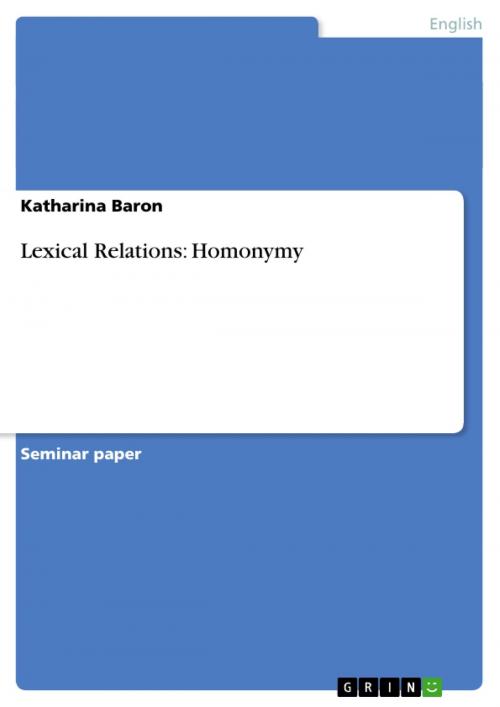| Author: | Katharina Baron | ISBN: | 9783638388559 |
| Publisher: | GRIN Publishing | Publication: | June 19, 2005 |
| Imprint: | GRIN Publishing | Language: | English |
| Author: | Katharina Baron |
| ISBN: | 9783638388559 |
| Publisher: | GRIN Publishing |
| Publication: | June 19, 2005 |
| Imprint: | GRIN Publishing |
| Language: | English |
Seminar paper from the year 2005 in the subject English Language and Literature Studies - Linguistics, grade: 2,3, http://www.uni-jena.de/ (Institut für Anglistik/Amerikanistik), course: Proseminar: Lexical Relations, 9 entries in the bibliography, language: English, abstract: Comunicating via language is a significant property of human beings. The Oxford English Dictionary contains about 400 000 lexemes and the vocabulary of an average English speaker covers 250 000 words. During normal conversations about 4,000 or 5,000 words are used per hour and while reading a person reaches an amount of 14,000 or 15,000 words in an hour.1 Usually one does not think about any relations between the words, the words we need in a particular situation come to our mind and we use them because they fulfill the function of communicating with others. When communicating via language we do not think about where the words historically come from or how they are related to each other. From the linguistic point of view the words are not single units for themselves they are linked to each other by semantic (paradigmatic and syntagmatic) and formal relations. Syntagmatic relations are explained on the basis of meaning of words and paradigmatic relations deal with semantic and grammatical features. Formal relations are based on the form of lexemes. The focus of this paper will be on homonymy, which is a formal relationship between lexemes. In the first part the phenomenon will be explained in regard to its types, development and problems which can arise from homonymy. In the second part examples of homonymous lexemes will be analysed. It will be explained which type of homonymy they belong to, why they are homonyms and which problems can arise in written and spoken language when those homonymous lexemes are used. 1 See: Aitchison, Jean, Linguistics (London: Hodder Headline Plc, 1999) 3.
Seminar paper from the year 2005 in the subject English Language and Literature Studies - Linguistics, grade: 2,3, http://www.uni-jena.de/ (Institut für Anglistik/Amerikanistik), course: Proseminar: Lexical Relations, 9 entries in the bibliography, language: English, abstract: Comunicating via language is a significant property of human beings. The Oxford English Dictionary contains about 400 000 lexemes and the vocabulary of an average English speaker covers 250 000 words. During normal conversations about 4,000 or 5,000 words are used per hour and while reading a person reaches an amount of 14,000 or 15,000 words in an hour.1 Usually one does not think about any relations between the words, the words we need in a particular situation come to our mind and we use them because they fulfill the function of communicating with others. When communicating via language we do not think about where the words historically come from or how they are related to each other. From the linguistic point of view the words are not single units for themselves they are linked to each other by semantic (paradigmatic and syntagmatic) and formal relations. Syntagmatic relations are explained on the basis of meaning of words and paradigmatic relations deal with semantic and grammatical features. Formal relations are based on the form of lexemes. The focus of this paper will be on homonymy, which is a formal relationship between lexemes. In the first part the phenomenon will be explained in regard to its types, development and problems which can arise from homonymy. In the second part examples of homonymous lexemes will be analysed. It will be explained which type of homonymy they belong to, why they are homonyms and which problems can arise in written and spoken language when those homonymous lexemes are used. 1 See: Aitchison, Jean, Linguistics (London: Hodder Headline Plc, 1999) 3.















